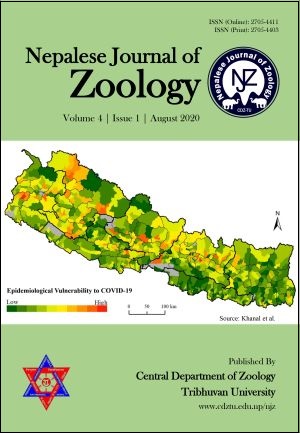Distribution of Chinese pangolin (Manis pentadactyla) in Nagarjun forest of Shivapuri Nagarjun National Park, Nepal
DOI:
https://doi.org/10.3126/njz.v4i1.30667Keywords:
Burrows, Camera traps, Critically endangered, MammalsAbstract
The Chinese pangolin (Manis pentadactyla) is one of the world’s critically endangered species, and its distribution is little known in Nepal. This study aimed at understanding the distribution of Chinese pangolin in Nagarjun forest of Shivapuri-Nagarjun National Park, Nepal from September 2017 to May 2018. A total of 15 infrared cameras were used, these were installed randomly in the forest. Only three cameras at three different locations were able to capture photographs of Chinese pangolin. Altogether, three events, comprising 21 still photos of pangolin, their sign and other mammal species in the area were recorded. In addition, 94 pangolin burrows were noticed in the study area. The distribution of Chinese pangolin is influenced by the food, tree canopy and aspect of the area. Majority of the active burrows were found near to feeding burrows where ants and termite’s nest were found abundantly. In addition to Chinese pangolin, the study was able to capture twelve mammalian species including masked palm civet (Paguma larvata) and yellow-throated marten (Martes flavigula). These two species were often seen to enter or try to enter the active burrows of pangolins. The results suggest that Nagarjun Forest serves an important role in mammal conservation with high mammalian biodiversity.
Downloads
Downloads
Published
How to Cite
Issue
Section
License
This license enables reusers to distribute, remix, adapt, and build upon the material in any medium or format for noncommercial purposes only, and only so long as attribution is given to the creator.

